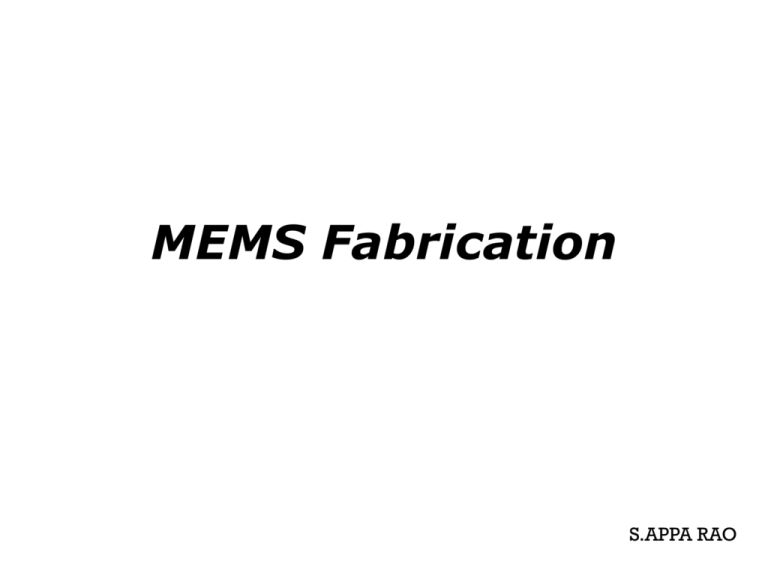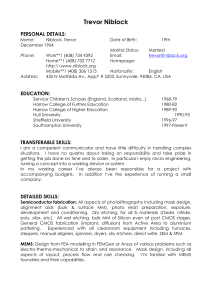File
advertisement

MEMS Fabrication S.APPA RAO Overview • What are MEMS? • MEMS: Micro-Electro-Mechanical Systems => ‘smalltech’ • MEMS Applications • MEMS fabrication process • Future of MEMS technology MEMS Overview • • • • Micro Electro Mechanical Systems Micron level mechanical parts Made from transistor materials and metals Van Der Waals forces – Intermolecular bonding – Plays an important part in design http://searchcio-midmarket.techtarget.com/definition/micro-electromechanical-systems What are MEMS? • Combination of mechanical functions (sensing, moving, heating) and electrical functions (switching ,deciding) on the same chip using micro fabrication technology • Lab on a Chip (LOC) • System on a Chip • Micro-sensors / micro-actuators • Small silicon cantilevers (AFM tips) etc The Role of MEMS While the functional elements of MEMS are miniaturized structures, sensors, actuators, and microelectronics, the most notable (and perhaps most interesting) elements are the microsensors and microactuators. Microsensors and microactuators are appropriately categorized as “transducers”, which are defined as devices that convert energy from one form to another. In the case of microsensors, the device typically converts a measured mechanical signal into an electrical signal. Micro-Electro-Mechanical Systems, or MEMS, is a technology that in its most general form can be defined as miniaturized mechanical and electromechanical elements (i.e., devices and structures) that are made using the techniques of microfabrication. The critical physical dimensions of MEMS devices can vary from well below one micron on the lower end of the dimensional spectrum, all the way to several millimeters. Michael Huff, Michael Huff is at the MEMS Exchange, Corporation for National Research Initiatives, 1895 Preston White Drive, Suite 100, Reston, Virginia 20191-5434, USA MEMS Ratchet Imagine a machine so small that it is imperceptible to the human eye. Imagine working machines no bigger than a grain of pollen. Imagine thousands of these machines batch fabricated on a single piece of silicon, for just a few pennies each. Imagine a world where gravity and inertia are no longer important, but atomic forces and surface science dominate. Imagine a silicon chip with thousands of microscopic mirrors working in unison, enabling the all optical network and removing the bottlenecks from the global telecommunications infrastructure. You are now entering the micro-domain, a world occupied by an explosive technology known as MEMS. A world of challenge and opportunity, where traditional engineering concepts are turned upside down, and the realm of the "possible" is totally redefined. http://www.memx.com/ MEMS Applications • Accelerometers in consumer electronics devices such as game controllers • Automotive applications (20 per vehicle) • Communications (telecom) • Biotechnology (Lab on a Chip) • System on a Chip MEMS Architecture MEMS Accelerometer MEMS are quietly changing the way you live, in ways that you might never imagine. The device that senses your car has been in an accident, and fires the airbag is a MEMS device. Most new cars have over a dozen MEMS devices, making your car safer, more energy efficient, and more environmentally friendly. MEMS are finding their way into a variety of medical devices, and everyday consumer products. (From MEMX http://www.memx.com/ ) MEMS Advantages • Significantly lower manufacturing costs (semiconductor process) • Small inertial mass • Particularly realized in the area of: – sensors – signal switching Materials for MEMS • Materials are the foundation required to develop microsensors. MEMS are made of: • Metals • Polymers • Ceramic materials • Semiconductors • Composite materials MEMS Process • Same as the process steps used for making conventional electronic circuits Fabrication Process http://www.aero.org/publications/helvajian/helvajian-2.html Fabrication Process Fabrication Process Fabrication Techniques • • • • • Mask Lithography Injection molding Microstereolithography Silicon Surface Micromachining Silicon Bulk Micromachining Mask Lithography • Use of photo resist – Positive • Dissolves under light – Negative • Hardens under light – Both get covered with desired material, then photo resist is dissolved by a solvent • Multiple layers – Multiple steps Mask Lithography Thin Film Deposition • • • • • Deposition techniques: Chemical Deposition Chemical Vapor Deposition Physical Vapor Deposition DC magnetron sputtering Lithography • Application of photo resist • Optical exposure to print an image of the mask onto the resist • Immersion in an aqueous developer solution to dissolve the exposed resist MEMS Accelerometer • Made of bulky and heavy metal parts • Require high operating voltage/current • Needs careful maintenance • Highly expensive not throwaway type CONVENTIONAL ACCELEROMETER SENSOR Piezoresistive Accelerometer Masks used for Accelerometer http://www.pcb.com/Accelerometers/Sensing_Technologies.asp Layout of the Resistor Injection Molding • • • • Starts with mask lithography Metal poured over resist Resist gets dissolved Metal form is left for plastic injection molding Injection Molding Microstereolithography • Similar principal to mask lithography, but for 3D pieces • Uses an “active mask” – Not a physical mask • Utilizes a photo-reactive acrylic resin • Each layer image projected through a DMD(digital mirror device) • Projected into the resin – Uses lenses • Resin that is illuminated, Cross-links and hardens • Piece is then covered in a hardened layer Microstereolithography • Dimensional capabilities – Lateral and Vertical resolution: 10μm – Maximum field size: 10.24mm x 7.68mm – Structural height: up to 5mm Microstereolithography http://www.sciencedirect.com/science/article/pii/S0924424799001892 Microstereolithography Micromachining Technology The three characteristic features of MEMS fabrication technologies are miniaturization, multiplicity, and microelectronics. Miniaturization is clearly an important part of MEMS, since materials and components that are relatively small and light enable compact and quickresponse devices. Multiplicity refers to the batch fabrication inherent in semiconductor processing. Consequently, it is feasible to fabricate thousands or millions of components as easily and concurrently as one component, thereby ensuring low unit component cost. Furthermore, multiplicity provides flexibility in solving mechanical problems by enabling the possibility of a distributed approach through use of (coupled) arrays of micromechanical devices. Finally, microelectronics provides the intelligence to MEMS and allows the monolithic merger of sensors, actuators, and logic to build closed-loop feedback components and systems. http://www.aero.org/publications/helvajian/helvajian-2.html Types of Micromachining • BULK micromachining: • SURFACE micromachining: • LIGA process: Silicon Surface Micromachining • • • • Uses the same process as IC fabrication Needs multiple layers to create structures Cheapest form of Micromachining Similar to lithography – Sacrificial material – Structural material • When sacrificial material is removed, only whole structures are left Silicon Surface Micromachining Silicon Surface Micromachining Silicon Surface Micromachining Silicon Bulk Micromachining • • • • Done with Crystalline silicon Constructed using etch stop planes Chemical process Anisotropic Etching – Speed dependent – Directional – etch in different crystallographic directions at different rates – Slower directions create and etch stop plane Wet Etching and Plasma Dry Etching Wet etching where the material is dissolved when immersed in a chemical solution Dry etching where the material is sputtered or dissolved using reactive ions or a vapor phase etchant http://www.memsnet.org/mems/beginner/etch.html Deep Reactive Ion Etching (DRIE) Uses photo resist and a mask to create structures http://en.wikipedia.org/wiki/Deep_reactive-ion_etching Sapphire Etching • Metal Mask, 100µm etch depth, .28µm/min etch rate, Chlorine etching Pressure Sensor Etching • Used on silicon, Metal mask, .81µm etch depth, Utilizes Fluorine, High-Speed Etching • Silicon material, 1µm/min etch rate, W-Si Mask http://upload.wikimedia.org/wikipedia/commons/1/17/Bosch_process_sidewall.jpg MEMS Technical Limitations • • • • Imprecise fabrication methods Expensive and complex packaging CAD Design tool inaccuracies Limits to miniaturization – Material process limitations – Functional engineering limits Future of MEMS • As with all emerging technologies, the MEMS industry had been predicted to revolutionize technology and our lives. • MEMS may be incorporated in biological structures, linked by wireless networks • It has the potential to change our daily lives as much as computers / networks – Computation, communication and actuation Summary • • • • MEMS – Micro Electro Mechanical Systems Fabricated using silicon fabrication tools Lithography, mask/etc, deposit/etch etc MEMS can be fabricated out of a number of materials: polymers, ceramics, metals, etc • Fabless ICs are used by many MEMS designers • Polymeric and ceramic MEMS are also made References • • • • • • http://home.earthlink.net/~trimmerw/mems/tour.html http://home.earthlink.net/~trimmerw/mems/BM_bulk.html http://www.samcointl.com/apps/mems.html http://www.cmf.rl.ac.uk/latest/msl.html http://www.chemguide.co.uk/atoms/bonding/vdw.html “Micromachining for Optical and Optoelectronic Systems”. MING C. WU



